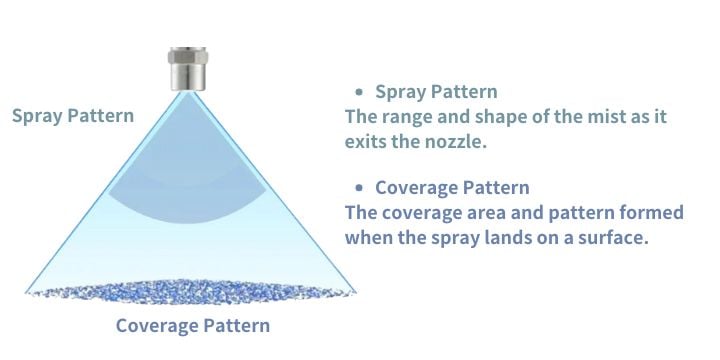หัวฉีดมีหลายประเภทและมีฟังก์ชันที่แตกต่างกัน ตั้งแต่หัวฉีดพ่นแบบพัดลม หัวฉีดพ่นแบบกรวยตัน หัวฉีดพ่นแบบกรวยกลวง ไปจนถึงหัวฉีดพ่นแบบเกลียว รูปแบบการพ่นที่แตกต่างกันไม่เพียงส่งผลต่อพื้นที่ครอบคลุม แต่ยังส่งผลต่อความเข้มและประสิทธิภาพของการพ่นอีกด้วย ดังนั้น การเลือกหัวฉีดที่เหมาะสมจึงเป็นงานที่ต้องพิจารณาอย่างละเอียด บทความนี้จะแนะนำลักษณะของรูปแบบการพ่นของหัวฉีด ประเภทของการกระจายตัวของของไหล และอื่น ๆ
1. รูปแบบการพ่นคืออะไร?

ไม่ใช่ทุกชื่อของหัวฉีดจะมาจาก "รูปร่างของการพ่นของของเหลวบนพื้นผิว" เพื่อช่วยให้ผู้อ่านเข้าใจได้ดีขึ้น บทความนี้จะใช้ "รูปแบบการพ่น" และ "รูปแบบการครอบคลุม" เพื่อระบุชัดเจนถึงตำแหน่งและขอบเขตที่กล่าวถึง
- รูปแบบการพ่น
หมายถึง รูปร่างของละอองเมื่อออกจากหัวฉีด แม้ว่ารูปแบบการพ่นอาจเปลี่ยนเล็กน้อยตามการเปลี่ยนแปลงของความดันพ่น แต่หัวฉีดส่วนใหญ่จะรักษารูปแบบการพ่นให้คงที่ ขนาดและสัดส่วนของการพ่นอาจเปลี่ยนไปตามสภาพการใช้งาน
- รูปแบบการครอบคลุม
หมายถึง รูปร่างและพื้นที่ที่ละอองพ่นลงบนพื้นผิว ขนาดการครอบคลุมได้รับผลกระทบจากปัจจัยต่าง ๆ เช่น มุมพ่นของหัวฉีด ระยะการพ่น และความดัน มุมพ่นที่ใหญ่ขึ้นจะส่งผลให้พื้นที่ครอบคลุมกว้างขึ้น ในขณะที่ระยะการพ่นและความดันจะมีผลต่อขนาดและความสม่ำเสมอของการครอบคลุม
2. ประเภทของรูปแบบการพ่นของหัวฉีด